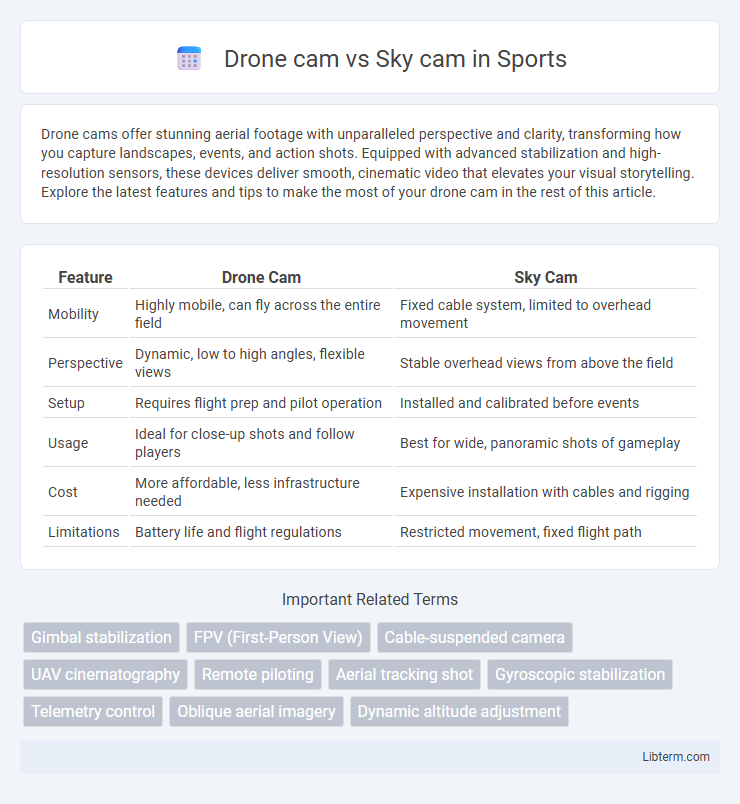Drone cams offer stunning aerial footage with unparalleled perspective and clarity, transforming how you capture landscapes, events, and action shots. Equipped with advanced stabilization and high-resolution sensors, these devices deliver smooth, cinematic video that elevates your visual storytelling. Explore the latest features and tips to make the most of your drone cam in the rest of this article.
Table of Comparison
| Feature | Drone Cam | Sky Cam |
|---|---|---|
| Mobility | Highly mobile, can fly across the entire field | Fixed cable system, limited to overhead movement |
| Perspective | Dynamic, low to high angles, flexible views | Stable overhead views from above the field |
| Setup | Requires flight prep and pilot operation | Installed and calibrated before events |
| Usage | Ideal for close-up shots and follow players | Best for wide, panoramic shots of gameplay |
| Cost | More affordable, less infrastructure needed | Expensive installation with cables and rigging |
| Limitations | Battery life and flight regulations | Restricted movement, fixed flight path |
Introduction to Drone Cam and Sky Cam
Drone cam, equipped with advanced aerial technology, captures dynamic, high-resolution footage from various altitudes and angles, ideal for sports, events, and cinematic uses. Sky cam operates on a fixed cable system, offering stable, precise overhead shots predominantly in stadiums and large venues, enhancing broadcast perspectives during live events. Both cameras revolutionize visual storytelling by delivering unique, immersive viewer experiences through versatile filming techniques.
Key Differences Between Drone Cam and Sky Cam
Drone cams offer versatile aerial shots with the ability to move freely over various terrains, equipped with stabilizers for smooth footage and remote control operation, ideal for dynamic, mobile filming. Sky cams, fixed to a cable system above stadiums or events, provide stable, sweeping overhead views but lack the mobility of drones, functioning best in controlled environments. The key difference lies in mobility and setup: drone cams excel in flexible, outdoor shooting, while sky cams deliver consistent, high-angle perspectives in fixed locations.
Technology Behind Drone Cam Systems
Drone cam systems utilize advanced multi-rotor technology combined with compact, high-resolution cameras stabilized by 3-axis gimbals, enabling smooth aerial footage and precise maneuverability. These drones often feature GPS-based navigation, obstacle avoidance sensors, and real-time video transmission for enhanced control and safety in dynamic environments. Unlike sky cams, which rely on fixed cable rigs and mechanical pulleys for movement, drone cams leverage autonomous flight technology and AI-powered path planning to capture versatile and adaptive shot compositions.
Technology Behind Sky Cam Systems
Sky cam systems utilize advanced cable-suspended technology combined with gyro-stabilized cameras to deliver precise, high-definition aerial footage with minimal vibration. The integration of automated winch systems allows dynamic and smooth camera movement across large stadium spaces, offering unique angles impossible for traditional drones. These systems rely heavily on real-time data processing and programmable control interfaces to maintain stability and responsiveness during live broadcasts.
Versatility and Applications in Various Industries
Drone cams offer unparalleled versatility with their ability to maneuver in tight spaces, capture dynamic aerial perspectives, and adapt to diverse environments, making them ideal for industries such as agriculture, real estate, and filmmaking. Sky cams, typically fixed to cables or rigs, provide stable, smooth, and consistent overhead shots, frequently used in sports broadcasting and live event production where controlled camera movement over a designated area is essential. The choice between drone cams and sky cams depends on the specific application requirements, with drone cams excelling in mobility and sky cams in stability for high-impact visual coverage.
Image Quality and Filming Capabilities
Drone cams deliver superior image quality through advanced stabilization technology and high-resolution sensors, enabling sharp, cinematic aerial footage even in dynamic environments. Sky cams, typically suspended by cables within stadiums, provide stable, sweeping shots with limited movement range but excel in capturing live sports action with real-time responsiveness. The choice depends on desired filming capabilities: drones offer versatile, creative angles with smooth mobility, while sky cams ensure consistent, controlled shots ideal for immersive event coverage.
Maneuverability and Coverage Area
Drone cameras offer exceptional maneuverability with the ability to fly at various altitudes and angles, enabling dynamic shots in tight spaces and complex environments. Sky cams, typically suspended on cables, provide stable, wide-area coverage primarily for sports arenas and large events but have limited mobility compared to drones. The flexible positioning of drone cams allows for versatile aerial perspectives, whereas sky cams excel in providing consistent overhead views within a fixed coverage zone.
Cost Comparison: Drone Cam vs Sky Cam
Drone cams typically cost between $1,000 and $25,000 depending on drone size, camera quality, and features, making them more affordable for small productions. Sky cams, often exceeding $100,000, require specialized rigging, operator expertise, and infrastructure, which significantly increase overall expenses. Budget-conscious projects often favor drone cams due to lower maintenance and operational costs compared to the high investment and complexity associated with sky cams.
Safety, Regulations, and Legal Considerations
Drone cams offer enhanced flexibility and aerial perspectives but face stringent aviation regulations and strict licensing requirements to ensure pilot competency and public safety. Sky cams, typically installed on fixed rigs in stadiums or studios, provide reliable, controlled footage with minimal risk to bystanders and are subject to fewer regulatory constraints. Both technologies demand adherence to privacy laws and operational guidelines to prevent legal issues and ensure safe usage in public and private spaces.
Choosing the Right Camera System for Your Project
Choosing the right camera system for your project depends on factors like shot flexibility, budget, and environment. Drone cams offer dynamic aerial perspectives with high mobility, ideal for outdoor or large-scale productions, while sky cams provide stable, overhead shots controlled by cables, perfect for indoor or sports events requiring precise positioning. Evaluate the scale, location, and desired shot angles to determine whether the versatile drone cam or the controlled, fixed-path sky cam best suits your production needs.
Drone cam Infographic

 libterm.com
libterm.com